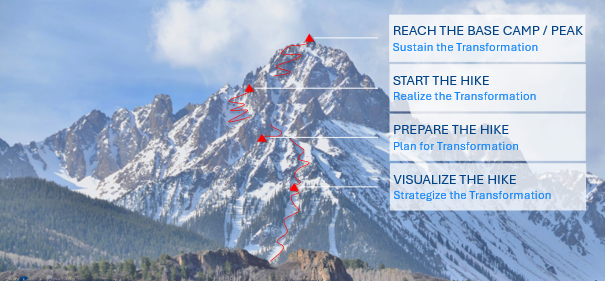
Risk & Resilience in Logistics Network Design
Reimagine resilience and proactively minimize supply chain risks

Manufacturing companies are seeking to transition from machine-based production lines to “smart factories” for enhanced efficiency, reduced costs, and improved quality among many other benefits. The adoption of cutting-edge technologies holds the potential to transform the industry by using artificial intelligence (AI), robotics, and automation to boost productivity and address labor shortages, leveraging data analytics to enhance forecasting and reduce disruptions, and utilizing the Internet of Things (IoT) to improve connectivity. Still, many companies struggle to embark on their digital manufacturing journey. To support organizations during this transformation, we have identified four essential steps to guide you towards realizing a smart factory. It is the key to successfully hike up the mountain of digital manufacturing transformation and reach the peak!
Camelot’s Digital Manufacturing Consulting
Organizations striving for a competitive edge and leveraging AI are focusing on smart factory to realize their Industry 4.0 vision. The benefits of comprehensive digitization across the borders of production are vast including increased revenue, optimized operations, and improved working capital leading to higher customer satisfaction. According to Gartner Inc., 54% of manufacturers are increasing their invest in technology in 2024 to address challenges in the areas of finding qualified talent and acquiring new customers. Particularly among growing organizations, there is a trend to allocate 10% or even more technology budget in comparison to last year.
In this blog article, we will focus on the critical aspects of the transformation hike towards manufacturing and operational excellence with a focus on solution selection, the successful solution deployment as well as solution adoption.
Before beginning your hike towards achieving digital manufacturing excellence, it is essential to envision your journey — in other words to strategize and plan your transformation. What are your current and future business challenges including your operation model? Which technology will best address your business needs? What are desired outcomes or success criteria?
It is vital at this stage of the hike to secure executive sponsorship and engage the cross-functional teams’ vision to gain stakeholder buy-in. Moreover, it is crucial to recognize that reaching the peak — your goal of operation excellence — may not happen in one go “big bang”. You might need to set intermediate goals, or “base camps,” to reflect on your journey and achievements and to reassess before continuing further.
The Camelot solution tour is addressing the aspects to identify your technology potential and to fully understand your business needs. This comes in a variety of result-oriented formats, including solution demos, success stories, and an experience day which delivers a clear roadmap for your transformation.

The key to any kind of success is preparation. That is why the second stage of the hike is all about planning the transformation. This begins with a thorough evaluation of your business situation, processes, solutions, and technology landscape. Here, a holistic check of your manufacturing processes as well as IT-OT devices, infrastructure, architecture, and software solutions is important.
In today’s dynamic manufacturing landscape, global organizations need an advanced Manufacturing Execution System (MES) to drive operational excellence, improve efficiency, and stay competitive. Companies have to select a combination of mature technology and application stack that is robust, scalable, and allows seamless integration to deliver end-to-end value chain processes and lays the digital foundation to realize AI use cases.
To accelerate the transformation, a structured solution exploration approach is needed that validates that the identified technology or solution is appropriate for your organization’s specific context and justifies the required investment budget. Depending on the existing knowledge and manufacturing technology maturity, organizations can choose from a custom demo to a solution prototype.
With SAP Digital Manufacturing in the cloud, organizations can benefit from a cloud-based, scalable Manufacturing Execution System (MES) that enables global manufacturers to manage and control manufacturing and shop floor operations and realize Industry 4.0 scenarios. Additionally, the SAP Business Technology Platform (BTP) provides the flexibility needed to tailor extensions to SAP standard functionalities, realizing a competitive advantage. It also provides the possibility for organizations to leverage SAP’s business AI assistant Joule realizing AI-driven insights and automation across SAP solutions.
An important aspect of preparing and planning the transformation is the selection of the implementation approach. Here, organizations need to choose between a Greenfield, Brownfield, or Bluefield approach depending on their existing system landscape and manufacturing vision:
The third step of the hike is the actual transformation by implementing and deploying a future-ready and scalable software stack that integrates with your organization’s business processes and systems. During this realization phase, it is important to address not only technological aspects but also the business requirements for production-critical processes like sustainability, quality, and maintenance, as well as industry-specific needs (e.g., chemicals, food & beverages, discrete manufacturing/automotive).
For an accelerated deployment of SAP Digital Manufacturing technology, customers can leverage our starter-kit concept featuring ready-to-use templates and pre-configured solutions. This approach reduces the implementation effort and risk by leveraging best practices, thus delivering faster Return on Investment (ROI).
The final step is either reaching a base camp — an intermediate milestone — or the peak, the goal of your transformation. One of the factors to differentiate base camp achievements from reaching the peak is the decision between a big bang versus a pilot project and rollout approach. Step three and four as well as the overall journey will be different for every organization, as they have different maturity levels, prerequisites, and transformation pace. Even after the successful completion of a project, it is essential to secure the long-term success of your transformation. In this context, every ending marks the beginning of the next chapter – the next base camp or peak.
Digital transformation is a continuous process, and an innovative solution combined with a scalable technology stack is essential but not sufficient on its own. That is why step four is all about staying thirsty, sustaining the realized transformation for the organization, and fostering a culture of continuous improvement and innovation. This is particularly crucial in the cloud environment where frequent release cycles introduce new features that can add tremendous value. An excellence framework is required which uniquely blends technology, process, and industry knowledge to deliver business, application, and user adoption services. These services focus on advisory, improvements, and business operations. That way, organizations stay ahead of their competition, adapt to evolving technologies, and fully realize the potential of their transformation.
Would you like to learn more? Download our free white paper here!

Reimagine resilience and proactively minimize supply chain risks

This article shall help you to understand how to optimize your inventory positions in a month – or even less.

Modern PLM systems empower businesses to achieve product excellence in fast-paced markets by enhancing collaboration, agility and innovation.

Read how the Campaign Planner & Designer (CPD) helps you to manage supply chain variability.
© Camelot Management Consultants, Part of Accenture
Camelot Management Consultants is the brand name through which the member firms Camelot Management Consultants GmbH, Camelot ITLab GmbH and their local subsidiaries operate and deliver their services.